The Prequel to Hobo Dismount: Truck Dismount
Truck Dismount by Jetro is the sequel to his runaway paste-around, Stair Dismount. The core concept remains the same: Mangle the ragdoll. This time, though, the poor guy is on and around a moving truck instead of a static set of stairs.
Optimizing Sliders
The gameplay hook is the same as Stair Dismount. You as the player configure the playfield: how fast the truck moves, where the ragdoll starts, windshield on or off, the location of the speed bumps, and so. After you press “go”, you simply sit back and watch.
Experimentation is key. Is it better to put the ragdoll man on top of the car so he flies off? Or inside, to begin with, and hope he falls out if the truck tips over? Does a slower-moving truck mean a longer time to deal damage?
Extrapolation of the Genre
Truck Dismount is fun, for a bit, but it suits players who prefer to optimize a single set of variables. Even with the inherent replay value of physics games, I get bored easily. Personally, I would love to see the hurt-the-ragdoll concept extended far past a simple scenario. Imagine a street intersection with a bunch of ragdolls: You choose when the grandma ragdoll starts to cross the street, when two cars depart, and where the paperboy ragdoll goes on his bike. I could play with that for the better part of an hour. The possibility space of a set of stairs or a truck, a wall, and two speed bumps is really quite limited by comparison.
Pick up the Pace
My other gripe with the Dismount games is their pacing. Now, granted, this is obviously a design decision, and there is a certain mesmerizing allure to the lack of interactivity in the current games. Personally, I would love to see more action and faster motion. Fire a ragdoll out of a cannon, or strap one to a stunt-jumping motorbike, or something. Toss some explosions in there. The dynamism of a physics engine isn’t being exploited to its fullest with damped, lethargic motion.
Content?
Finally, the single scenario provided in Truck Dismount wears out pretty quickly. If you’ve spent an hour fiddling with the game once, you really don’t have much a reason to come back to it ever again. It would be great to see more scenarios in future games [editor’s note: there’s actually a level editor in the up-and-coming Dismount Levels game].
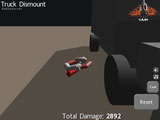
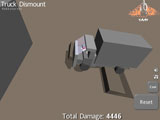
(Truck Dismount Game Screenshots)
It’s Free, It’s Fun!
Still, Truck Dismount is a great extension of the original Dismount concept. I think at some point in their childhood everyone smashed up an action figure or doll. Truck Dismount lets you tap into that adolescent urge again and again. Best of all, nobody actually gets hurt (unless you play enough to get wrist pains, of course, in which case you should really look into getting a pair of Softflex gloves).
Download Truck Dismount game here (2.0 MB), or head on over to Jetro’s Dismount page for the other titles.
Related Posts:
- List of MacOS Physics Games
- Classic Physics Game: Stair Dismount
- List of Physics Games
- Interview: Peter Stock, Armadillo Run
- Pogoriffic Pogo Ponies: Pogo Sticker
Playground Soccer: Super Stealball
Super Stealball is a new game by Matteo Guarnieri of Rag Doll Software (makers of Ragdoll Masters–check out the game and interview here on the site). After a departure from ragdolls with N-Ball, Matteo has returned to his forte with a great use of the Ragdoll Masters engine. His site describes the game as:
Super Stealball is a crazy sports-like game in which players compete for the control of a ball. Ragdolls fly around in low gravity dribbling and tackling opponents in order to keep the ball of their colour.
Game Rules and Strategies
The rules of Super Stealball are simple. Each arena has 2-4 ragdolls and a ball. If you touch the ball it changes to your color until someone else touches it. Retain control of the ball for long enough and you pass the level.
These rules result in several viable strategies, depending on how many opponents you’re up against and the arena’s shape. In an open arena with smooth walls, you can simply try to keep the ball ahead and out of reach of your opponent by scooting along the outside way. Occasional direction changes will throw off the chase.
With more opponents, though, and in more irregularly-shaped arenas, your best bet is usually to hover around the ball and try to keep yourself between the ball and oncoming ragdolls. It’s much more like fending off attackers than it is playing keep-away.
Enemy AI
The AI in Super Stealball can be awfully crafty. The game gets harder by increasing the difficulty of the AI’s logic, rather than by cheating in some way. On the plus side, you can learn from the AI’s technique, but when you do lose it can be a tad frustrating. After all, the computer just beat you with the exact same capabilities you posses. Creating AI is one of the difficult challenges when it comes to creating physics games, and Matteo does this very well.
The AI seems to try position itself between you and the ball, and it does a pretty good job of doing so. It’s actually more difficult to combat in the one-on-one matches. When there are multiple opponents they each have their own color and don’t work together. As a result it’s easier to worm your way in and maximize your ball time, particularly because you can pick on whichever AI color is ahead.
Flow
Playing Super Stealball is an interesting exercise in flow. On occasion you will have a very articulated thought–crap, I need to stop Green from getting more ball time–but on the whole you generally achieve a state of flow and stare thoughtless at the monitor. It’s like playing in a very engaging physical sport. You simply do. When you’re “on” you know it. The enemy seems powerless to stop you, and you manage to dominate the match. It’s a rewarding feeling.
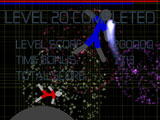
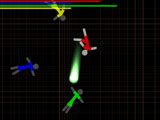
(Super Stealball Game Screenshots)
It’s a Steal
The full version of Super Stealball is priced at $9.95. At the time of this writing, though, the whole Rag Doll Software lineup is available half-price. Super Stealball is a great game to get in and out of quickly, and at $4.95 how can anyone resist?
Head on over to the Super Stealball page at Rag Doll Software to download the free demo (2.89 MB) or order the full version of this great physics game.
Related Posts:
- List of MacOS Physics Games
- List of Physics Games
- iPhone Physics Games Launch in July
- Excellent Marble Madness-Inspired Physics Game
- One-Part Tetris, One-Part Physics: Triptych
Merry-Goo-Round: Tower of Goo
Tower of Goo by Kyle Gabler is a product of the inaugural Experimental Gameplay Project. Kyle was a member of the first group of Carnegie Mellon University students. Since then, the project has grown–expanding in scope past the Entertainment Technology Center–but Tower of Goo is still a seminal example of the program’s success [pun intended].
Structural Integrity…Failing!
Tower of Goo is best described as Bridge Builder in real-time. The little blobs of goo crawling around your tower can be picked up and dropped as supports. Clicking on a piece of goo and dragging it around will highlight available locations: either as one span between two existing points, or two spans for a new point connecting two existing points. It makes a lot more sense when you see it in action–check the video.
Like many of the Experimental Gameplay Project games, there is no explicit goal in Tower of Goo. Implicitly, however, the goal is to build up. The game’s sole bit of statistical feedback is how tall your tower is. When you reach new heights, a happy bit of text appears as reward.
Blue Team, Goo!
What’s great about Tower of Goo is that the little blob guys, your resources, aren’t static. They actively climb around the tower trying to reach the highest point. Their weight will actually affect the tower, too, so if they all climb to one side of the tower you may need to quickly counteract by adding some weight to the other side. If your tower starts to significantly fall, you’re usually screwed; maybe some quick repair on the weak side will fix it. Maybe. Usually not, and everything comes crashing to the ground. No worries, though–you simply keep building from where things lay. There’s no timer and no game-imposed punishments.
Multiple Play Styles
The real-time nature of Tower of Goo supports multiple play styles. One player can choose to build slowly and carefully, making sure everything is stable before expanding. Or, and this is how I usually play, one can play very quickly. Careful placement isn’t as important as growing your structure as fast as possible. Of course, this typically results in a catastrophic failure of the tower at some point. But hey–that’s most of the fun.
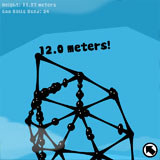
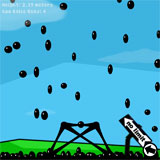
(Tower of Goo Game Screenshots)
It’s Goo Time
The original Tower of Goo took four days of Kyle’s time to develop. Since then, he’s released Tower of Goo Unlimited which enables unlimited vertical/horizontal expansion. It’s remarkably fun to play with, although without the meta structure of game goals on top of the mechanic it will get a little old. Still, it’s a small download and it’s totally free. Why aren’t you playing it already?
Download Tower of Goo Unlimited here (2.32 MB), or head over to the Experimental Gameplay Project website for more information.
Related Posts:
- A Classic: Bridge Builder by Chronic Logic
- The Beginning
- Builder Physics Games Evolved: Armadillo Run
- When You’re Mining for Gold, and You Forget…
- List of Physics Games


 (Rate this game! 176 votes, average: 4.09 out of 5)
(Rate this game! 176 votes, average: 4.09 out of 5)
 My name is Matthew Wegner, and this site is dedicated to physics games.
My name is Matthew Wegner, and this site is dedicated to physics games.